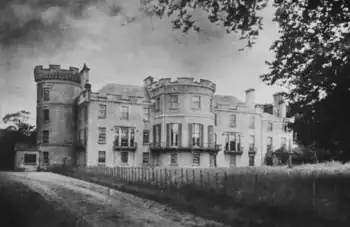William Ramsay Ramsay | |
|---|---|
| Member of Parliament for Stirlingshire | |
| In office 11 May 1831 – 27 December 1832 | |
| Preceded by | Henry Home-Drummond |
| Succeeded by | Charles Elphinstone Fleeming |
| Member of Parliament for Midlothian | |
| In office 6 July 1841 – 23 June 1845 | |
| Preceded by | William Gibson-Craig |
| Succeeded by | John Hope |
| Personal details | |
| Born | 29 May 1809 |
| Died | 15 March 1850 (aged 40) |
| Nationality | British |
| Political party | Conservative/Tory |
William Ramsay Ramsay of Barnton and Sauchie (29 May 1809 – 15 March 1850)[1][2] was a British Conservative Party and Tory politician.[3][4]
Life

He was born in Barnton House west of Edinburgh, on 29 May 1809, the eldest son of George Ramsay and his wife Jean Hamilton, daughter of John Hamilton Baron Belhaven. Barnton House (previously known as Cramond Regis) was commissioned by his father in 1784 to replace an earlier house, and was designed by Robert Adam. It was extended by architect David Hamilton in 1810.[5]
He was privately tutored then studied at Christ Church, Oxford graduating in 1828, and later that year married Mary Sandilands, daughter of James Sandilands, 10th Lord Torpichen—with whom he had 1 son, Charles William Ramsay (1844–1865). He inherited the estates of his father when "still an infant", an event which saw him conferred the distinction of "the richest commoner in Scotland".[4]
Ramsay was elected Tory MP for Stirlingshire at the 1831 general election, when invited to do so by Thomas Stirling, and campaigned on a platform of a determination to "uphold unimpaired the institutions of the country". He said, however, he was "free and unfettered from any pledges whatever" but claimed to be "friendly to a fair, liberal safe and equitably reform" but "decidedly opposed" to "altogether too sweeping and irrevocable reforms". In the House of Commons, he voted against the second and third readings of the English reform bill and voted to reject the second reading of the Scottish version of the bill. He stood down at the next election a year later. He was later, in 1841, elected Conservative MP for Midlothian, but resigned four years later by accepting the office of Steward of the Chiltern Hundreds.[6][3][1][2][4]
He died in Barnton House on 15 March 1850. He was succeeded by his only son, Charles William Ramsay, aged only six. Charles died unmarried and childless 15 years later.[7]
Barnton House was demolished around 1960 but the Gothic style gatepiers of 1810 still exist on Whitehouse Road.
References
- 1 2 Rayment, Leigh (23 June 2018). "The House of Commons: Constituencies beginning with "M"". Leigh Rayment's Peerage Page. Archived from the original on 2 August 2018. Retrieved 18 August 2019.
{{cite web}}: CS1 maint: unfit URL (link) - 1 2 Rayment, Leigh (13 June 2017). "The House of Commons: Constituencies beginning with "S"". Leigh Rayment's Peerage Page. Archived from the original on 14 September 2018. Retrieved 18 August 2019.
{{cite web}}: CS1 maint: unfit URL (link) - 1 2 Smith, Henry Stooks (1842). The Register of Parliamentary Contested Elections (Second ed.). Simpkin, Marshall & Company. pp. 200, 211–212. Retrieved 14 September 2018 – via Google Books.
- 1 2 3 Jenkins, Terry. "RAMSAY, William Ramsay (1809-1850), of Barnton House, Edinburgh and Sauchie House, Stirling". The History of Parliament. Retrieved 18 August 2019.
- ↑ "Edinburgh, Barnton Avenue West, Barnton House | Canmore".
- ↑ Craig, F. W. S., ed. (1977). British Parliamentary Election Results 1832-1885 (e-book) (1st ed.). London: Macmillan Press. ISBN 978-1-349-02349-3.
- ↑ "RAMSAY, William Ramsay (1809-1850), of Barnton House, Edinburgh and Sauchie House, Stirling | History of Parliament Online".
External links